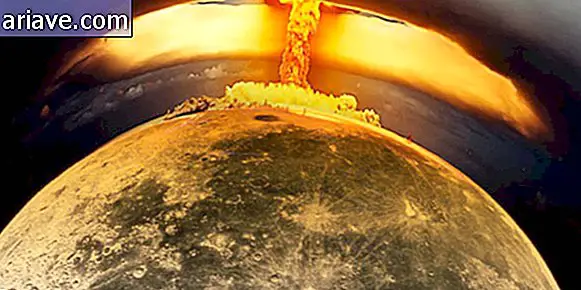Learn what happened after an asteroid collision 65 million years ago
About 65 million years ago, a space rock estimated to be between 10 and 80 kilometers in diameter collided with our planet, triggering a chain of events that led not only to the extinction of dinosaurs - not birds - but also the disappearance of 75% of life on earth. There is no doubt that the impact had devastating effects in the long run, but how soon did the tragedy go? According to a recent study by scientists at the University of Texas, the following days were marked by destruction, chaos, darkness and death.
The most catastrophic day in history
The impact gave rise to a gigantic 180 km diameter crater on Mexico's Yucatán Peninsula, known by the name of Chicxulub - the only crater in the world that, besides the typical circular rim, has an inner ring formed by rocks. Here's an image to better understand what we just described:

For the researchers went to the crater and collected cores of sediment accumulated in this central ring of Chicxulub and, after analyzing the material - obtained between 500 and a little over 1, 300 meters deep - made a reconstruction of what happened afterwards. of the asteroid crashing into our planet. And, look… no wonder so many species went into extinction.
Dramatic reenactment
According to the researchers, the asteroid released an amount of energy equivalent to the explosion of 10 billion atomic bombs, and immediately after impact, a 40-meter-thick layer of rocks that melted into the collision emerged. And as the asteroid crashed near the coast, the seawater lying there crashed into the crash - forming hundreds of feet high waves that traveled thousands of miles away.

To give you an idea, the tsunamis reached the Great Lakes region of the north, and when the waters receded, they dragged sediment back into the crater - in the Caribbean! - depositing around 130 meters of material inside the first 24 hours of the catastrophe.
The researchers also found in the samples collected traces of coal suggesting that the collision set off fires - which, according to the team, spread over distances between 1, 000 and 1, 500 kilometers from the impact site. But calm down ... There's more!

The collision, besides melting an enormous amount of rocks, caused many of them to vaporize. Then the impact sulfates mingled with the water vapor and landed in the atmosphere, completely blocking the sun's rays and plunging the planet into darkness.
These particles eventually began to dissipate, but the researchers' analysis suggests that Earth's temperatures dropped by 7 ° C, and the effects of this global cooling lasted for at least 30 years. According to predictions, it is only a matter of time before the Earth is struck again by such a devastating space rock that collided with us 65 million years ago - but hopefully humanity is no longer here to witness such a thing. event!











